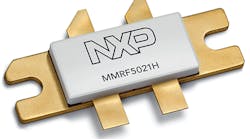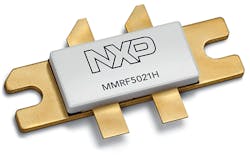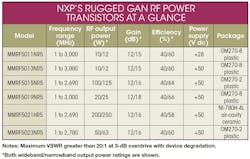The MMRF5019NR5 operates between 1 and 3,000 MHz with RF output power of 20 W CW broadband and 25 W CW narrowband output power and 66% efficiency. It is designed to drive the MMRF5021HR5 output-stage device, which operates between 1 and 2,700 MHz and is tailored for wideband applications, delivering 250 W CW with 58% efficiency (see figure).
Finally, model MMRF5023NR5 also operates between 1 and 2,700 MHz, producing 50 W CW broadband and 63 W CW narrowband output power with 60% efficiency. Additional specifications are shown in the table.
All of the devices have a broad frequency range from HF to S-band, making it possible to reduce the number of RF power transistors required for broadband amplifiers in EW systems and battlefield radios. The result is a reduction in design complexity, as well as in the bill of materials (BOM) for those systems.
Since the company increased its support of defense applications in 2013, it has expanded its range of RF power transistors for EW and communications applications—as well as for HF, VHF, UHF, and L-band radar; identify-friend-or-foe (IFF) transponders; and avionics systems. In addition to GaN devices, the firm offers more than 40 LDMOS transistors between 1 to 3,000 MHz, from low power levels to 1,500 W CW—currently the highest RF output power available from a single device over its operating frequency range of 1,030 to 1,090 MHz. The six new GaN transistors are either sampling or in production.
David Lewicki, Military Products Manager, RF Power
NXP Semiconductors, 1300 North Alma School Rd., Chandler, AZ 85224
Looking for parts? Go to SourceESB.



